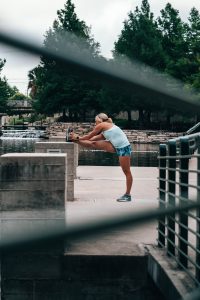Stretching Techniques to Minimise Injury
If you are thinking of running more frequently, here’s how you can apply stretching techniques to reduce your chances of injury.

It is fairly common knowledge that you should always do some stretching before and after exercise. This evidently includes running as an activity – no matter if it’s a sprint, or a long-distance run. Even seasoned athletes take precaution to stretch their muscles before performing their exercises. Despite the frequency of their physical performance, there’s no telling how a sore muscle or injury can set them back from achieving their physical goals.
The truth is, it generally would take more time for an athlete to recover from serious sporting related injuries, than it would for them to progressively train to achieve their exercise goals. While the general idea would be for runners to perform an adequate amount of stretching activity before and after their runs, how else can a person incorporate stretching to help sustain their desire to run more frequently? Read on to see what we at Runners Tech Perth have to offer, when it comes to advocating stretching techniques to prevent injury and aid your progress as a runner in Perth.
Should You Only be Stretching Your Legs?
It doesn’t take an in-depth understanding of the human anatomy to learn about the muscles that support you while you run. Generally, your quads, hamstrings and calves are the muscles that work to propel you forward with each of your steps. These muscles are all a part of a runner’s legs – which simply means that any amount of running will inevitably result in strengthening them.
Considering how crucial these muscles are to a runner’s performance, it’s generally good practice to ensure that you stretch them before and after a run. Static stretches like lunges, calf stretches and squats will be adequately effective when it comes to preparing a runner for a run, or for cooling down right after one. They can easily be performed without the need for equipment – all you’ll need is a little bit of room and a flat enough area to stretch out in comfortably.
An extra tip that our team at Runners Tech Perth can provide here, is that you may want to consider stretching a couple of additional muscle groups apart from just the ones involved with moving your legs. Your leg muscles (quads, hamstrings, calves) may work actively to propel you forwards while you run, but your abdominal and gluteal muscles also provide a crucial function of supporting your pelvis while you maintain a running momentum. Taking care of these supporting muscle groups will help you to improve your gait and overall running performance, so be sure to also throw in some crunches and gluteal stretches as part of your new stretching routine.
What’s the Difference between Stretching and Warming Up?
There may be athletes and professional runners in Perth who believe it’s better to do your stretching after a run. The reasoning behind this lies with the idea that it’s better to stretch warm muscles than it is to stretch cold, or inactive ones. Regardless of which camp of reasoning you may gravitate towards, plenty of runners in Perth would unanimously agree on the benefits that a good warm up can bring to any run. A stretch can be defined as an exercise movement that helps an athlete improve the elasticity of their muscles. From this understanding, it’s easy to see how a good amount of stretching activity helps to prepare a runner’s muscles for the amount of sustained rigour experienced during a run.
If you find yourself opposed to the idea of stretching before a run, consider a warm up instead. These can take the form of static activities such as jogging on the spot, as a way to activate your muscles, bring your heart rate up, and rev up your cardiovascular system. All this considered, spending five or ten minutes on a warm up is a great way to help your body prepare itself for a sustained run – especially if you are among runners in Perth who worry about stitches or feeling out of breath midway through a run.
Targeted Training of Muscles
If you are among runners in Perth who are ambitious enough to take your running performance to a semi-professional level of athleticism, consider how spending a bit of time in the gym can help you become a more effective runner. Going back to the importance of stretching out your active and supporting muscle groups prior to a run, it may be highly beneficial for you to consider strengthening these very same muscle groups as a way to enhance your ability as a runner.
Simple weightlifting exercises like squats and lunges are great for this purpose, as they are compound exercises that work on a group of both your active and supporting muscles. The idea here is simple: the stronger these individual muscles are, the easier it becomes to sustain your activity during a run, and the slimmer your chances are of pulling a muscle after a strenuous run along your favourite route in Perth.
Don’t Forget to Cool Down
Stretching after a run helps to lengthen the muscles that you’ve just put to work. With blood already flowing through your active and supporting muscles, a cool down stretch helps decrease tightness in your muscles. Stretching after a run also helps to prevent your muscles from coming to rest abruptly – this can cause pain for some runners, as your muscles may pull on joints if you do not spend an adequate amount of time stretching them after activity. Remember: what goes up must eventually come down, and the same goes likewise for runners finishing up with a satisfying run